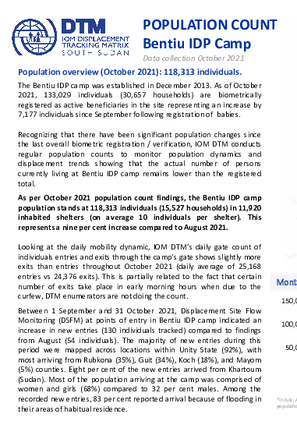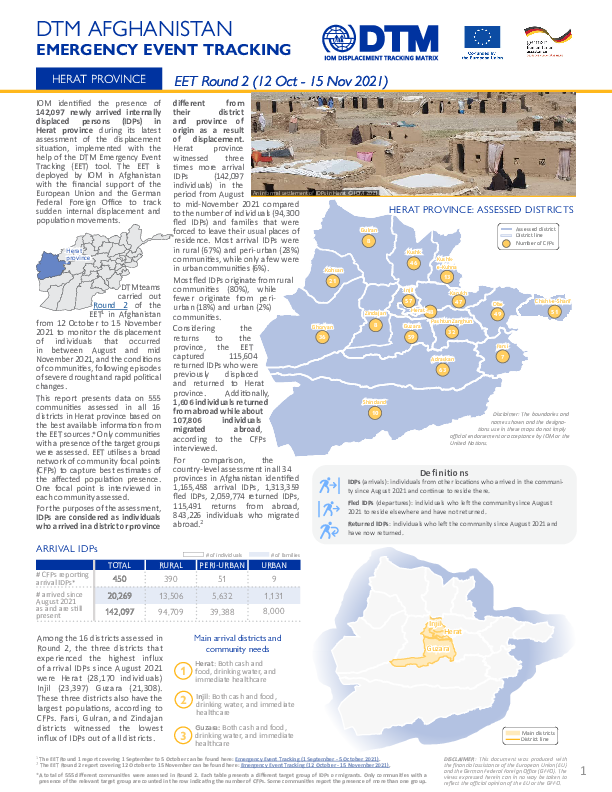-
Countries
-
Data and Analysis
-
Special Focus
-
Crisis Responses

Contact
DTM South Sudan, SouthSudanDTM@iom.int
Language
English
Location
South Sudan
Period Covered
Oct 01 2021
Oct 31 2021
Activity
- Site Assessment
- Registration
- Flow Monitoring
- Mobility Tracking
DTM conducts regular population counts to monitor population dynamics and displacement trends. The October 2021 population count in Bentiu IDP camp found the camp population to stand at 118,313 individuals (15,527 households) in 11,920 inhabited shelters (on average 10 individuals per shelter), representing a nine per cent increase since August 2021. This compares to the biometric registration figures from October 2021, which recorded 133,029 individuals (30,657 households) registered as active beneficiaries in the site, representing an increase by 7,177 individuals since September 2021 following registration of babies.

Contact
DTM Uganda, dtmuganda@iom.int
Language
English
Location
Uganda
Period Covered
Nov 01 2021
Nov 30 2021
Activity
- Mobility Tracking
In November, the nation experienced floods, heavy storms/hailstorms, fires, transport-related accidents, Collapsed Structures/Buildings/Earth/Quarry and the two explosions that rocked Kampala city, killing at least seven people.
Floods were reported in Kasese in the west and Kampala, affecting 685 individuals. At least 994 persons were affected by heavy storms/hailstorms in Rakai, Kasese, Sironko and Bukomansimbi; 850 by fires in Wakiso and Bundibugyo; 358 by terrorism in Kampala; and 182 by transport-related accidents and collapse of buildings in Masindi, Buliisa, Kampala and Wakiso.
Hazards affected 3,071 persons in 642 households.745 individuals and 381 households were internally displaced, with 37 identified as persons with special needs. There is high priority need for hygiene promotion, health, water supply, sanitation, shelter, food assistance, NFIs, among others.

Contact
DTM Somalia, IOMSomaliaDTM@iom.int
Language
English
Location
Somalia
Period Covered
Nov 01 2021
Nov 30 2021
Activity
- Flow Monitoring
In November 2021, a total of 26,435 movements were observed at 7 Flow Monitoring Points (FMPs). This represents an increase of 43 per cent in comparison with November 2020 (8 months after the country’s first case of COVID-19) when 18,434 movements were observed.
Doolow, Bossaso, Lowyacado, Buuhoodle, Cabudwaaq and Dhobley FMPs recorded an increase in movements between these two periods (160%, 69%, 57%, 13%, 3% and 1%, respectively) while Harirad FMP recorded a decrease in movement (-57%).

Contact
DTM Nigeria, AllUsersInDTMNigeria@iom.int
Language
English
Location
Nigeria
Period Covered
Aug 30 2021
Oct 15 2021
Activity
- Mobility Tracking
- Baseline Assessment
This factsheet presents key findings from covers the period from 30 August to 15 October 2021, which presents the results from the Round 39 of Displacement Tracking Matrix (DTM) assessments carried out by the International Organization for Migration (IOM) in North East Zone.
During Round 39, DTM identified 2,200,357 IDPs (452,363 households) as well as 1,943,445 Returnees (313,834 households).

Contact
iombuenosaires@iom.int
Language
English
Location
Argentina
Period Covered
Oct 07 2021
Nov 08 2021
Activity
- Survey
- Flow Monitoring Survey
En la actualidad se estima que aproximadamente 5.6 millones de personas de nacionalidad venezolana residen fuera de su país, de las cuales 4.6 millones residen en países de América Latina y el Caribe1 . En la República Argentina, se estima que residen 174.333 personas venezolanas, siendo este flujo poblacional uno de los más dinámicos en años recientes en un país históricamente receptor de inmigración.
Los flujos de personas refugiadas y migrantes venezolanas revisten especial interés, dado que presentan necesidades específicas que los distinguen de otros grupos de inmigrantes de la región. Se trata de movimientos a gran escala, sostenidos en el tiempo, que requieren de soluciones políticas y solidaridad internacional. Con el fin de garantizar un enfoque integral y coordinado a nivel regional entre los gobiernos, actores de sociedad civil y la comunidad internacional, surge la Plataforma Regional de Coordinación Interagencial que fue creada en conformidad con la solicitud del Secretario General de las Naciones Unidas al ACNUR y la OIM el 12 de abril de 2018, para dirigir y coordinar la respuesta a los/as refugiados/as y migrantes de Venezuela.

Contact
DTM Mauritania, DTMMauritania@iom.int
Language
French
Location
Mauritania
Period Covered
Aug 01 2021
Aug 31 2021
Activity
- Survey
- Flow Monitoring Survey
- Flow Monitoring
La transhumance est une tradition de longue date en Mauritanie où elle a subi des évolutions majeures au cours des dernières décennies, comme la raréfaction des ressources impliquant la redéfinition des routes empruntées par les troupeaux. Par conséquent, des conflits peuvent survenir lorsque les agriculteurs et les transhumants utilisent les mêmes ressources ou quand les champs agricoles sont endommagés par le passage des troupeaux. Dans le cadre du Suivi des Mouvements de Transhumance, l’OIM met en œuvre un système d’alerte, qui a pour objectif de recenser les mouvements inattendus de bétail et conflits ou catastrophes naturelles liés à l’utilisation des ressources naturelles et aux pratiques agro-pastorales dans la région, de comprendre les modes de résolution de conflits existants et d’informer les autorités compétentes, dans l’objectif de réduire les tensions dans les régions d’intervention. Ce tableau de bord présente les informations fournies par le biais de 37 relais communautaires, présents dans sept régions (Trarza, Brakna, Gorgol, Guidimakha, Assaba, Hodh El Chargui et Hodh El Gharbi) pendant le mois d’août 2021.
Contact
DTM Yemen, iomyemendtm@iom.int
Location
Yemen
Activity
- Event Tracking
- Mobility Tracking
Period Covered
Dec 05 2021 -Dec 11 2021
From 01 January 2021 to 11 December 2021, IOM Yemen DTM estimates that 22,925 households (HH) (137,550 Individuals) have experienced displacement at least once.
Since the beginning of 2021, DTM also identified 4,404 displaced households who left their locations of displacement and either moved back to their place of origin or another location.
Between 05 and 11 December 2021, IOM Yemen DTM tracked 961 households (5,766 individuals) displaced at least once. The top three governorates and districts where people moved into/within are:
• Marib (607 HH) – Marib (323 HH), Marib City (284 HH) districts. Most displacements in the governorate were internal.
• Al Hodeidah (119 HH) – Al Khukhah (80 HH), Hays (39 HH) districts. Most displacements in the governorate were internal.
• Taiz (95 HH) – Mawza (41 HH), Al Makha (20 HH), Salah (14 HH) districts. Most displacements in the governorate originated from Taiz and Al Hodeidah.
Most displacements resulted from the increased conflict in the following governorates and districts.
• Marib (604 HH) – Marib (534 HH), Al Jubah (53 HH), Harib (10 HH) districts.
• Al Hodeidah (156 HH) – Hays (90 HH), Jabal Ras (28 HH), Al Jarrahi (23 HH) districts.
• Taiz (93 HH) – Maqbanah (71 HH), Sabir Al Mawadim (8 HH), At Taiziyah (3 HH) districts.
Population Groups
Survey Methodology
Unit of Analysis Or Observation
Type of Survey or Assessment
Keywords
Geographical Scope
Administrative boundaries with available data
The current dataset covers the following administrative boundaries

Contact
DTM Yemen, iomyemendtm@iom.int
Language
English
Location
Yemen
Period Covered
Dec 05 2021
Dec 11 2021
Activity
- Rapid Emergency Registration
- Mobility Tracking
IOM Yemen DTM’s Rapid Displacement Tracking (RDT) tool collects data on numbers of households forced to flee on a daily basis from their locations of origin or displacement, allowing for regular reporting of new displacements in terms of numbers, geography, and needs. It also tracks Returnees who returned to their location of origin.
From 01 January 2021 to 11 December 2021, IOM Yemen DTM estimates that 22,925 households (HH) (137,550 Individuals) have experienced displacement at least once.
Since the beginning of 2021, DTM also identified 4,404 displaced households who left their locations of displacement and either moved back to their place of origin or another location.
Between 05 and 11 December 2021, IOM Yemen DTM tracked 961 households (5,766 individuals) displaced at least once. The top three governorates and districts where people moved into/within are:
- Marib (607 HH) – Marib (323 HH), Marib City (284 HH) districts. Most displacements in the governorate were internal.
- Al Hodeidah (119 HH) – Al Khukhah (80 HH), Hays (39 HH) districts. Most displacements in the governorate were internal.
- Taiz (95 HH) – Mawza (41 HH), Al Makha (20 HH), Salah (14 HH) districts. Most displacements in the governorate originated from Taiz and Al Hodeidah.
Most displacements resulted from the increased conflict in the following governorates and districts.
- Marib (604 HH) – Marib (534 HH), Al Jubah (53 HH), Harib (10 HH) districts.
- Al Hodeidah (156 HH) – Hays (90 HH), Jabal Ras (28 HH), Al Jarrahi (23 HH) districts.
- Taiz (93 HH) – Maqbanah (71 HH), Sabir Al Mawadim (8 HH), At Taiziyah (3 HH) districts.
Some 162 HH displaced in the previous reporting period, which covered 28 November - 04 December 2021, in the governorates of Marib (76 HH), Taiz (53 HH), Al Hodeidah (18 HH), Aden (8 HH), Al Maharah (7 HH), were only identified in the current period and so, this figure has been added to the cumulative displacement total recorded from the beginning of the year.

Contact
DTM Afghanistan, DTMKabul@iom.int
Language
English
Location
Afghanistan
Period Covered
Oct 12 2021
Nov 15 2021
Activity
- Event Tracking
IOM identified the presence of 69,153 newly arrived Internally Displaced Persons (IDPs) in Kabul province during its latest assessment of the displacement situation, implemented with the help of the DTM Emergency Event Tracking (EET) tool. The EET is deployed by IOM in Afghanistan with the financial support of the European Union and the German Federal Foreign Office to track sudden internal displacement and population movements.
DTM teams carried out Round 2 of the EET1 in Afghanistan from 12 October to 15 November 2021 to monitor the displacement of individuals that occurred in between August and mid November 2021, and the conditions of communities, following episodes of severe drought and rapid political changes. This report presents data on 493 communities assessed in 14 (out of the 15) districts in Kabul province based on the best available information from the EET sources.* Only communities with a presence of the target groups were assessed. EET utilises a broad network of community focal points (CFPs) to capture best estimates of the affected population presence. One focal point is interviewed in each community assessed.

Contact
DTM Afghanistan, DTMKabul@iom.int
Language
English
Location
Afghanistan
Period Covered
Oct 12 2021
Nov 15 2021
Activity
- Event Tracking
IOM identified the presence of 142,097 newly arrived internally displaced persons (IDPs) in Herat province during its latest assessment of the displacement situation, implemented with the help of the DTM Emergency Event Tracking (EET) tool. The EET is deployed by IOM in Afghanistan with the financial support of the European Union and the German Federal Foreign Office to track sudden internal displacement and population movements.
DTM teams carried out Round 2 of the EET1 in Afghanistan from 12 October to 15 November 2021 to monitor the displacement of individuals that occurred in between August and mid November 2021, and the conditions of communities, following episodes of severe drought and rapid political changes.
This report presents data on 555 communities assessed in all 16 districts in Herat province based on the best available information from the EET sources.* Only communities with a presence of the target groups were assessed. EET utilises a broad network of community focal points (CFPs) to capture best estimates of the affected population presence. One focal point is interviewed in each community assessed.
